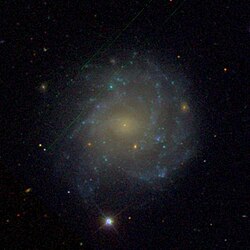| NGC 991 | |
|---|---|
 SDSS image of NGC 991 | |
| Observation data (J2000 epoch) | |
| Constellation | Cetus |
| Right ascension | 02h 35m 32.68341s [1] |
| Declination | −07° 09′ 15.8406″ [1] |
| Redshift | 0.005126 [2] |
| Heliocentric radial velocity | 1532.8 km/s [2] |
| Distance | 62.9 ± 4.5 Mly (19.28 ± 1.37 Mpc) [3] |
| Apparent magnitude (B) | 12.36 [2] |
| Characteristics | |
| Type | SAB(rs)c [3] |
| Other designations | |
| MCG -01-07-023, PGC 9846 [2] | |
NGC 991 is an intermediate spiral galaxy the constellation Cetus. This galaxy was discovered by astronomer William Herschel in 1785. [4] [5] [6]
Contents
One supernova has been observed in NGC 991: SN 1984L (type Ib, mag. 14) was discovered by Robert Evans on 28 August 1984. [7] [8] [9]